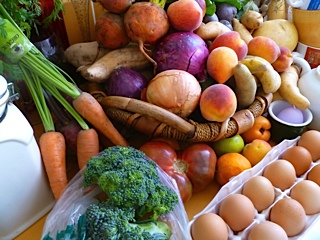Changing your lifestyle meets resistance from the outer world in odd and surprising ways.
Anyone trying to lose weight is well aware of this resistance! One's very own body seems to rise up like Darth Vader standing in your pathway. Like a monster in your dreams, former unhealthy choices hound the best laid plans. Hunger, cravings, comfort foods, and well meaning friends and family seem to come out of the woodwork carrying temptation on a platter ... a very 'yummy-looking' platter. Help! the dieter is heard moaning, as he/she crumbles again. And asks me, "What momentum?"
To achieve momentum despite resistance, the hopeful healthy soul could use some back-up. Self awareness, educated support, clever strategy... all are truly beneficial. But in my journey to health at a new phase in my life the last decade, I hit upon something almost akin to magic! that made this whole temptation thing see-through, basically stealing my habits' power away. Hunger. ...as in Real satiation! I mean to say, satisfying my body's hunger. Let me explain...
I knew that, since my teens, I had not actually felt real hunger anymore. My teen years is the timing of when the whole low-fat fad became promoted. My family, being good folk that wanted to support health for the whole family, fell right in with the new protocols. Of course they did! Low fat options were somewhat limited initially, but the big labels got busy filling the gaps. Shortly thereafter, my athletic teen body started putting on weight! Heaven forbid! I was a follower of Seventeen magazine! Fat was simply wrong, so I set about dieting at the tender age of 14.
Long story short, my own cycle of dieting, weight gain, dieting began.... but also, a constant search for the true healthy way to eat. I tried everything, vegetarianism, veganism (12 years of it), pescatarianism, fruitarian, fasting regularly, Atkins & South Beach, macrobiotics, more.... the list is too long! Through it all, I never actually experienced real hunger again (yep, even fasting). Years later, after nearly starving myself for years, and more overweight than ever!! I took a good long look at myself in the mirror before my birthday. I did not recognize this body. Thinking of my kids as well as personal goals, I made a covenant to get after nutrition research more deeply yet.
Deep research meant current research as well as research into the history of how we arrived at the current conflict between research, disease, lifestyle, regulatory bodies, and food manufacturers. As I read, I followed a mostly macrobiotic style of eating and worked hard at losing weight, working out, exercising, and firmly refusing temptation. Still I only lost 9 and 1/2 pounds in a year. Meanwhile, I discovered this thing called Banting; also known as High Fat Low Carb (HFLC), ketogenic diet, and a host of other names. Suspiciously, this sounded so much like how my family ate BEFORE the low fat fad took off. When my spouse took off for a long work trip, I took the alone time to try out Banting.
Bottom Line: In the following four months, I lost 40 pounds.
Holy Moly! Now I remembered hunger... NOT from starving but from satiation! Real satiation of my body's nutritional needs. Happy satiation that made cravings disappear! Satiation that made when and how much to eat vividly obvious. Coinciding with this wonderful experience, energy returned, mental clarity returned, frequent illness and allergic inflammation became minimal now, and the chronic pain of an old back injury with its associated fibromyalgia and rheumatism dialed down to very tolerable.
Lifestyle Modification Support (LMS) has been sharing the research some years now in these blog pages. So, I will not take this blog to go over it right now. But I would like to share a heartfelt post from someone who has recently experienced success. This share comes through the twitter community that is very active around HFLC (See Richard Lesar's happy tweet in the photo below). I also would like to share some of the resources 'out there' of medical and nutritional experts spreading this way of eating in detail.
The last thing I want to share is, as ridiculous as this is going to sound, I actually already knew of how to use ketogenics for medical reasons. In my nursing and medical practice, I referred certain patients to specialists who advised this very diet to manage epilepsy, inflammatory conditions, diabetes, and rapid weight loss management for those scheduled to go through bariatric surgery. But as I described above, my own body's long journey away from balanced health had become a monster I could only run from, rather than face. I had to turn around and face my monster directly, with dead seriousness. What is it going to take for you? to stop running scared and make a controlling decision to face down your overwhelming reason for dieting?
I wish you all the Best in your goals of rediscovering Balance. If I can answer questions or help you find what you are looking for to accomplish your goal, please contact me and ask. I am honoured to help.
Photo of Richard Lesar’s excellent results taken and used with Richard Lesar’s permission.
https://www.dietdoctor.com/authors/dr-jason-fung-m-d
http://www.total-health-fitness.com/blog/tim-noakes-diet
http://realmealrevolution.com/
Remember: Be Well and BE Happy!
~ J. Still MSN/FNP




![Smile... there is always a way to find balance! [Photo by Wylan Werth]](https://images.squarespace-cdn.com/content/v1/55ec7242e4b01fb4a6f066c0/1489351395718-G3T6KPJUJ89N0XAS6IFV/image-asset.jpeg)























